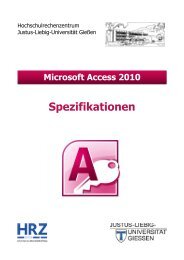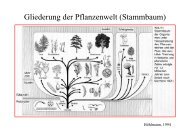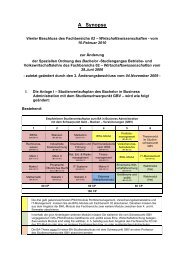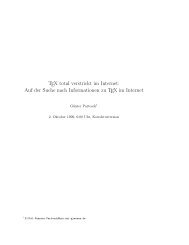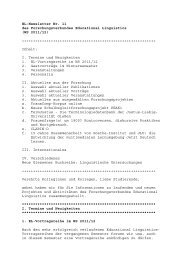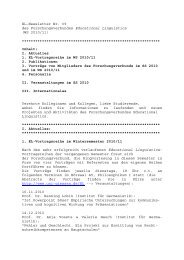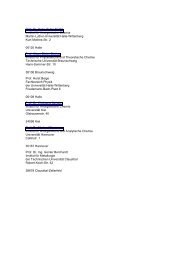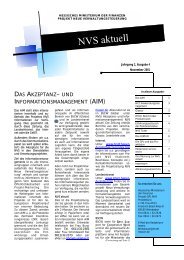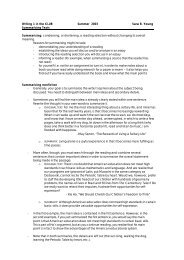Thermodynamik der Ernährung in SI – Einheiten - Justus-Liebig ...
Thermodynamik der Ernährung in SI – Einheiten - Justus-Liebig ...
Thermodynamik der Ernährung in SI – Einheiten - Justus-Liebig ...
Sie wollen auch ein ePaper? Erhöhen Sie die Reichweite Ihrer Titel.
YUMPU macht aus Druck-PDFs automatisch weboptimierte ePaper, die Google liebt.
<strong>Justus</strong> <strong>–</strong> <strong>Liebig</strong> <strong>–</strong> Universität Gießen<br />
Fachbereich 09<br />
Agrarwissenschaften, Ökotrophologie und Umweltmanagement<br />
Professur für Prozesstechnik <strong>in</strong> Lebensmittel- und Dienstleistungsbetrieben<br />
Studienarbeit<br />
<strong>Thermodynamik</strong> <strong>der</strong> <strong>Ernährung</strong> <strong>in</strong><br />
<strong>SI</strong> <strong>–</strong> E<strong>in</strong>heiten<br />
gestellt von: Prof. Dr.-Ing. Elmar Schlich<br />
betreut von: Prof. Dr.-Ing. Elmar Schlich<br />
angefertigt von: cand. B. Sc. Insa John<br />
Gießen, 29.09.2006
I. Kurzfassung<br />
Ziel dieser Arbeit ist es, Energieumsätze im menschlichen Organismus unter Berücksichtigung<br />
<strong>der</strong> Hauptsätze <strong>der</strong> <strong>Thermodynamik</strong> darzustellen. Dabei wird auf unterschiedliche<br />
Aspekte des Nahrungsenergieumsatzes sowie auf biochemische Abläufe<br />
e<strong>in</strong>gegangen. E<strong>in</strong> weiterer wichtiger Punkt ist die Darstellung von Leistungen, die <strong>der</strong><br />
menschliche Organismus erbr<strong>in</strong>gt.<br />
Um e<strong>in</strong>en E<strong>in</strong>stieg zu schaffen, erfolgt zunächst e<strong>in</strong>e Erläuterung <strong>der</strong> Grundlagen <strong>der</strong><br />
Systemtheorie und <strong>der</strong> <strong>Thermodynamik</strong>, sowie Aspekten <strong>der</strong> <strong>SI</strong>-E<strong>in</strong>heiten. Im Anschluss<br />
daran wird zum Erlangen e<strong>in</strong>es grundlegenden Verständnisses über biochemische<br />
Abläufe <strong>in</strong> <strong>der</strong> Zelle, die <strong>Thermodynamik</strong> <strong>der</strong> Zelle, sowie die Energiewährung<br />
des Körpers, das Adenos<strong>in</strong>triphosphat e<strong>in</strong>geführt. Es folgt e<strong>in</strong>e Präsentation<br />
<strong>der</strong> Energieumsätze des menschlichen Organismus. Dabei wird auf die Eigenschaften<br />
des Energiemetabolismus, sowie auf Methoden zur Bilanzierung <strong>der</strong> aufgenommenen<br />
Energie e<strong>in</strong>gegangen. Die Begriffe Grundumsatz, Leistungsumsatz und<br />
Thermoregulation werden e<strong>in</strong>geführt und energetisch bewertet. Zur Bewertung körperlicher<br />
Aktivität erfolgt anschließend mit <strong>der</strong> Kalorimetrie und <strong>der</strong> Ergometrie die<br />
Vorstellung zweier Methoden <strong>der</strong> Leistungsmessung, wobei <strong>der</strong> erhöhte Energieumsatz<br />
von Sportlern herausgestellt wird. Da <strong>der</strong> Umsatz <strong>der</strong> Energie liefernden Nährstoffe<br />
im menschlichen Organismus auf unterschiedlichen Wegen erfolgt und sie<br />
unterschiedliche Wirkungsgrade bezüglich <strong>der</strong> Energiebereitstellung besitzen, wird<br />
auf unterschiedliche Formen <strong>der</strong> energetischen Bewertung <strong>der</strong> Lebensmittel e<strong>in</strong>gegangen.<br />
Um e<strong>in</strong> Verständnis über die Abläufe bei <strong>der</strong> Energiebereitstellung im Muskel<br />
zu erlangen, werden biochemische Aspekte <strong>der</strong> Muskelkontraktion im Allgeme<strong>in</strong>en<br />
und <strong>der</strong> Kontraktion des Herzens im Speziellen erläutert. Des Weiteren erfolgt<br />
e<strong>in</strong>e Darstellung <strong>der</strong> Energiebereitstellung <strong>in</strong> Abhängigkeit von <strong>der</strong> Belastungsdauer.<br />
Im letzten Kapitel erfolgt die energetische Bewertung unterschiedlicher Aktivitäten,<br />
wobei im Speziellen auf die Unterschiede zwischen Gehen und Laufen und auf ökonomische<br />
Strategien des menschlichen Organismus e<strong>in</strong>gegangen wird.<br />
Es hat sich im Verlauf <strong>der</strong> Arbeit als schwierig dargestellt, Aktivitäten energetisch zu<br />
bewerten, da die Literatur zu diesem Thema sehr unterschiedliche Angaben macht.<br />
Außerdem hat es sich als notwenig herausgestellt, Angaben die <strong>in</strong> Kilokalorien gemacht<br />
waren, <strong>in</strong> Kilojoule umzurechnen. Des Weiteren s<strong>in</strong>d beim Schreiben immerneue,<br />
<strong>in</strong>teressante Aspekte aufgetaucht, die lei<strong>der</strong> nicht alle mit e<strong>in</strong>gebracht werden<br />
konnten.<br />
<strong>Thermodynamik</strong> <strong>der</strong> <strong>Ernährung</strong> <strong>in</strong> <strong>SI</strong>-E<strong>in</strong>heiten<br />
Vorgelegt von:<br />
Insa John<br />
I
II. Abstract<br />
The goal of this thesis is to present energy turnover of the human organism with consi<strong>der</strong>ation<br />
of the laws of thermodynamic. In the first place different aspects of foodenergyturnover<br />
as well as biochemical courses will be <strong>in</strong>troduced. Secondly important<br />
aspects of work capacity <strong>in</strong> the human body are presented.<br />
To beg<strong>in</strong>, the basis of systemtheorie and thermodynamics as well as the aspects of<br />
the “International System of Units” are <strong>in</strong>troduced. To achieve a basic knowledge of<br />
biochemical processes <strong>in</strong> cells, the thermodynamics of cells as well as the energy<br />
currency of the human organism, the ATP are established. In the next chapter a<br />
presentation of human energy turnover follows. Aspects of energy metabolism and<br />
Methods of balanc<strong>in</strong>g human energy <strong>in</strong>take will be <strong>in</strong>troduced. To cont<strong>in</strong>ue, the terms<br />
“basal metabolic rate”, “total energy expenditure” and “thermodynamic regulation” are<br />
established and valued energetically. To value physical activity, calorimetry and ergometry<br />
as methods of measur<strong>in</strong>g work capacity are <strong>in</strong>itiated. In this po<strong>in</strong>t the <strong>in</strong>creased<br />
energy expenditure dur<strong>in</strong>g physical activity is emphasized. S<strong>in</strong>ce energy<br />
turnover of the different nutrients varies between them and their degree of effectiveness<br />
alters, diverse ways to value food energy are <strong>in</strong>troduced. To achieve an un<strong>der</strong>statement<br />
of energy supply <strong>in</strong> the muscle, the biochemical aspects of muscle contraction<br />
<strong>in</strong> general and the contraction of the heart <strong>in</strong> special are elucidated. In the<br />
next place energy supply <strong>in</strong> dependence of load duration is presented. F<strong>in</strong>ally different<br />
activities are valued energetically. Moreover the differences <strong>in</strong> energy requirement<br />
between walk<strong>in</strong>g and runn<strong>in</strong>g as well as the economy of movement are revealed.<br />
While writ<strong>in</strong>g this bachelors thesis it occurred to be difficult to value different activities<br />
energetically because <strong>in</strong>formation on this topic varied <strong>in</strong> the literature. Furthermore it<br />
was necessary to recalculate statements presented <strong>in</strong> kilocalories to kilojoules. While<br />
writ<strong>in</strong>g other <strong>in</strong>terest<strong>in</strong>g aspects turned up which unfortunately cannot be presented<br />
<strong>in</strong> the thesis.<br />
<strong>Thermodynamik</strong> <strong>der</strong> <strong>Ernährung</strong> <strong>in</strong> <strong>SI</strong>-E<strong>in</strong>heiten<br />
Vorgelegt von:<br />
Insa John<br />
II



